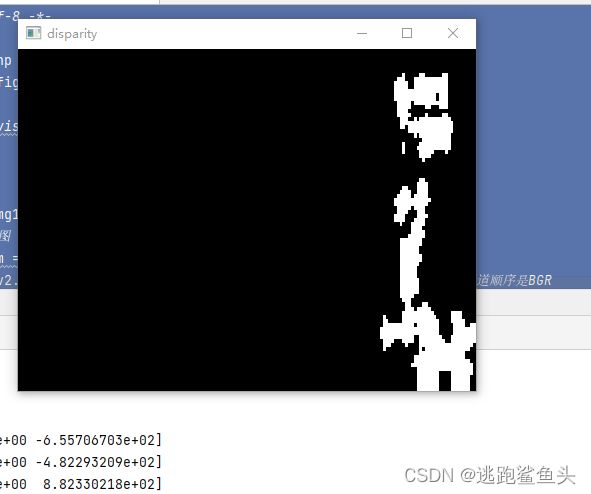双目测距 视差图(不完善)
博主INBC 删掉点云之后 效果
# -*- coding: utf-8 -*-
import cv2
import numpy as np
import stereoconfig_040_2 # 导入相机标定的参数
#import pcl
#import pcl.pcl_visualization
# 预处理
def preprocess(img1, img2):
# 彩色图->灰度图
if (img1.ndim == 3): # 判断为三维数组
img1 = cv2.cvtColor(img1, cv2.COLOR_BGR2GRAY) # 通过OpenCV加载的图像通道顺序是BGR
if (img2.ndim == 3):
img2 = cv2.cvtColor(img2, cv2.COLOR_BGR2GRAY)
# 直方图均衡
img1 = cv2.equalizeHist(img1)
img2 = cv2.equalizeHist(img2)
return img1, img2
# 消除畸变
def undistortion(image, camera_matrix, dist_coeff):
undistortion_image = cv2.undistort(image, camera_matrix, dist_coeff)
return undistortion_image
# 获取畸变校正和立体校正的映射变换矩阵、重投影矩阵
# @param:config是一个类,存储着双目标定的参数:config = stereoconfig.stereoCamera()
def getRectifyTransform(height, width, config):
# 读取内参和外参
left_K = config.cam_matrix_left
right_K = config.cam_matrix_right
left_distortion = config.distortion_l
right_distortion = config.distortion_r
R = config.R
T = config.T
# 计算校正变换
R1, R2, P1, P2, Q, roi1, roi2 = cv2.stereoRectify(left_K, left_distortion, right_K, right_distortion,
(width, height), R, T, alpha=0)
map1x, map1y = cv2.initUndistortRectifyMap(left_K, left_distortion, R1, P1, (width, height), cv2.CV_32FC1)
map2x, map2y = cv2.initUndistortRectifyMap(right_K, right_distortion, R2, P2, (width, height), cv2.CV_32FC1)
return map1x, map1y, map2x, map2y, Q
# 畸变校正和立体校正
def rectifyImage(image1, image2, map1x, map1y, map2x, map2y):
rectifyed_img1 = cv2.remap(image1, map1x, map1y, cv2.INTER_AREA)
rectifyed_img2 = cv2.remap(image2, map2x, map2y, cv2.INTER_AREA)
return rectifyed_img1, rectifyed_img2
# 立体校正检验----画线
def draw_line(image1, image2):
# 建立输出图像
height = max(image1.shape[0], image2.shape[0])
width = image1.shape[1] + image2.shape[1]
output = np.zeros((height, width, 3), dtype=np.uint8)
output[0:image1.shape[0], 0:image1.shape[1]] = image1
output[0:image2.shape[0], image1.shape[1]:] = image2
# 绘制等间距平行线
line_interval = 50 # 直线间隔:50
for k in range(height // line_interval):
cv2.line(output, (0, line_interval * (k + 1)), (2 * width, line_interval * (k + 1)), (0, 255, 0), thickness=2,
lineType=cv2.LINE_AA)
return output
# 视差计算
def stereoMatchSGBM(left_image, right_image, down_scale=False):
# SGBM匹配参数设置
if left_image.ndim == 2:
img_channels = 1
else:
img_channels = 3
blockSize = 3
paraml = {'minDisparity': 0,
'numDisparities': 128,
'blockSize': blockSize,
'P1': 8 * img_channels * blockSize ** 2,
'P2': 32 * img_channels * blockSize ** 2,
'disp12MaxDiff': 1,
'preFilterCap': 63,
'uniquenessRatio': 15,
'speckleWindowSize': 100,
'speckleRange': 1,
'mode': cv2.STEREO_SGBM_MODE_SGBM_3WAY
}
# 构建SGBM对象
left_matcher = cv2.StereoSGBM_create(**paraml)
paramr = paraml
paramr['minDisparity'] = -paraml['numDisparities']
right_matcher = cv2.StereoSGBM_create(**paramr)
# 计算视差图
size = (left_image.shape[1], left_image.shape[0])
if down_scale == False:
disparity_left = left_matcher.compute(left_image, right_image)
disparity_right = right_matcher.compute(right_image, left_image)
else:
left_image_down = cv2.pyrDown(left_image)
right_image_down = cv2.pyrDown(right_image)
factor = left_image.shape[1] / left_image_down.shape[1]
disparity_left_half = left_matcher.compute(left_image_down, right_image_down)
disparity_right_half = right_matcher.compute(right_image_down, left_image_down)
disparity_left = cv2.resize(disparity_left_half, size, interpolation=cv2.INTER_AREA)
disparity_right = cv2.resize(disparity_right_half, size, interpolation=cv2.INTER_AREA)
disparity_left = factor * disparity_left
disparity_right = factor * disparity_right
# 真实视差(因为SGBM算法得到的视差是×16的)
trueDisp_left = disparity_left.astype(np.float32) / 16.
trueDisp_right = disparity_right.astype(np.float32) / 16.
return trueDisp_left, trueDisp_right
# 将h×w×3数组转换为N×3的数组
def hw3ToN3(points):
height, width = points.shape[0:2]
points_1 = points[:, :, 0].reshape(height * width, 1)
points_2 = points[:, :, 1].reshape(height * width, 1)
points_3 = points[:, :, 2].reshape(height * width, 1)
points_ = np.hstack((points_1, points_2, points_3))
return points_
# 深度、颜色转换为点云
def DepthColor2Cloud(points_3d, colors):
rows, cols = points_3d.shape[0:2]
size = rows * cols
points_ = hw3ToN3(points_3d)
colors_ = hw3ToN3(colors).astype(np.int64)
# 颜色信息
blue = colors_[:, 0].reshape(size, 1)
green = colors_[:, 1].reshape(size, 1)
red = colors_[:, 2].reshape(size, 1)
rgb = np.left_shift(blue, 0) + np.left_shift(green, 8) + np.left_shift(red, 16)
# 将坐标+颜色叠加为点云数组
pointcloud = np.hstack((points_, rgb)).astype(np.float32)
# 删掉一些不合适的点
X = pointcloud[:, 0]
Y = -pointcloud[:, 1]
Z = -pointcloud[:, 2]
remove_idx1 = np.where(Z <= 0)
remove_idx2 = np.where(Z > 15000)
remove_idx3 = np.where(X > 10000)
remove_idx4 = np.where(X < -10000)
remove_idx5 = np.where(Y > 10000)
remove_idx6 = np.where(Y < -10000)
remove_idx = np.hstack(
(remove_idx1[0], remove_idx2[0], remove_idx3[0], remove_idx4[0], remove_idx5[0], remove_idx6[0]))
pointcloud_1 = np.delete(pointcloud, remove_idx, 0)
return pointcloud_1
# 点云显示
# def view_cloud(pointcloud):
# cloud = pcl.PointCloud_PointXYZRGBA()
# cloud.from_array(pointcloud)
#
# try:
# visual = pcl.pcl_visualization.CloudViewing()
# visual.ShowColorACloud(cloud)
# v = True
# while v:
# v = not (visual.WasStopped())
# except:
# pass
if __name__ == '__main__':
i = 3
string = 're'
# 读取数据集的图片
t = str(i)
iml = cv2.imread(r'D:\dht\qipange\right\right_' + t + '.jpg', 1) # 左图
imr = cv2.imread(r'D:\dht\qipange\left\left_' + t + '.jpg', 1) # 右图
height, width = iml.shape[:2]
#height, width = iml.shape[0:2]
print("width = %d \n" % width)
print("height = %d \n" % height)
# 读取相机内参和外参
config = stereoconfig_040_2.stereoCamera()
# 立体校正
map1x, map1y, map2x, map2y, Q = getRectifyTransform(height, width, config) # 获取用于畸变校正和立体校正的映射矩阵以及用于计算像素空间坐标的重投影矩阵
iml_rectified, imr_rectified = rectifyImage(iml, imr, map1x, map1y, map2x, map2y)
print("Print Q!")
print(Q)
# 绘制等间距平行线,检查立体校正的效果
line = draw_line(iml_rectified, imr_rectified)
cv2.imwrite('./%s检验%d.png' % (string, i), line)
# 消除畸变
iml = undistortion(iml, config.cam_matrix_left, config.distortion_l)
imr = undistortion(imr, config.cam_matrix_right, config.distortion_r)
# 立体匹配
iml_, imr_ = preprocess(iml, imr) # 预处理,一般可以削弱光照不均的影响,不做也可以
iml_rectified_l, imr_rectified_r = rectifyImage(iml_, imr_, map1x, map1y, map2x, map2y)
disp, _ = stereoMatchSGBM(iml_rectified_l, imr_rectified_r, True)
cv2.imwrite('./%s视差%d.png' % (string, i), disp)
# 计算像素点的3D坐标(左相机坐标系下)
points_3d = cv2.reprojectImageTo3D(disp, Q) # 可以使用上文的stereo_config.py给出的参数
# points_3d = points_3d
# 鼠标点击事件
def onMouse(event, x, y, flags, param):
if event == cv2.EVENT_LBUTTONDOWN:
print('点 (%d, %d) 的三维坐标 (%f, %f, %f)' % (x, y, points_3d[y, x, 0], points_3d[y, x, 1], points_3d[y, x, 2]))
dis = ((points_3d[y, x, 0] ** 2 + points_3d[y, x, 1] ** 2 + points_3d[y, x, 2] ** 2) ** 0.5) / 1000
print('点 (%d, %d) 距离左摄像头的相对距离为 %0.3f m' % (x, y, dis))
# 显示图片
cv2.namedWindow("disparity", 0)
cv2.imshow("disparity", disp)
cv2.setMouseCallback("disparity", onMouse, 0)
# 构建点云--Point_XYZRGBA格式
pointcloud = DepthColor2Cloud(points_3d, iml)
# 显示点云
#view_cloud(pointcloud)
cv2.waitKey(0)
cv2.destroyAllWindows()
